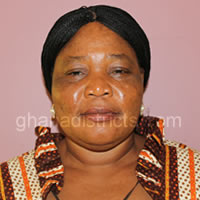WATER AND ENVIRONMENTAL SANITATION
A critical analysis of the distribution of the services in the District reveals that access is skewed in favour of urban settlements to the detriment of rural areas.
Safe Water
The availability and accessibility to potable water is of great concern to the household members in the District because not only is water a necessity but also a source of many diseases (water borne) especially among children. Accessibility also affects productivity especially among women and children who are the traditional water bearers. The main sources of drinking water in the urban settlements are pipe borne water, boreholes and unprotected wells, whereas boreholes, unprotected wells and rivers or streams are dominant source for rural areas.
In 2016 it was estimated that about 46 percent of the people had no access to safe drinking water. The figure increased to 49 percent in 2017 Access to safe drinking water is lower in the rural communities. About a third (33%) of households in rural areas do not have access to safe drinking water compared to 14 percent in the urban communities who do not have access. Areas where streams and rivers are major sources of water have serious implications on the health of the people.
Solid waste disposal
In terms of solid waste, using the public dumping sites (open space) is the main method of disposal among households in the district. It accounts for more than two-thirds (77%) of the methods used by households in the district. The situation eventually gives rise to the creation of refuse heaps which will require huge sums of money to evacuate. As a result, the District can currently count about thirty-seven (37) various sizes of refuse heaps scattered throughout the District. The use of public dump (container) is the second most common (9.1%) method of waste disposal among households. Dumping indiscriminately is also high accounting for 6.2 percent and may serve as breeding grounds for many kinds of ailments and spread of communicable diseases such as cholera in those areas.
Similarly, public dumping (open space) is the most predominant method used by urban and rural households accounting 76.5 percent and 77.6 percent respectively. Close to seven percent (6.5%) of the households in the urban areas dump indiscriminately while there are 5.9 percent in the rural localities.
The Assembly is in the process of acquiring a permanent final waste disposal site at Tuobodom. This is estimated to have a capacity for about 59 years. It is estimated to receive a total of about 15m3 of solid waste daily.
Transportation of solid waste is also on communal basis solely by the District Assembly in partnership with Zoomlion Company. The Assembly‘s Zoomlion truck is used to either collect waste store in refuse containers, waste from public cleansing or to evacuate heaps of refuse. The roll on, roll off truck is mounted with an empty container. This is exchanged with a full container at the sanitary sites to be emptied at the final disposal site under a pre-arranged routine programme. The empty container is then exchanged at the next sanitary site.
The arrangement helps to maximize collection through savings on collection-time, fuel and other running costs of vehicles however; there is the need to carry out time-motion study to determine the fastest and most economical routine for waste collection vehicles. Also an attendant must be at post at the final disposal sites during the working day to record all discharges in a landfill report book. Log book should also be introduced into each vehicle and inspected regularly to enable monitoring of collection.
Although the District Assembly had a programme to involve the private sector in waste management and payment of fees, the accessory managerial and political will could not be mustered to implement it, since it meant asking the community members to pay for services. The notion that everything, including refuse collection, should be free need to be discouraged if efficient service is to be provided.
Liquid Waste Disposal /Management
Liquid waste management involves the dislodging, collection, conveyance, treatment and disposal of the liquid waste. It also includes storm water drainage and sullage conveyance in the district. Liquid waste collection, particularly sewage is about to start. Five main types of toilet facilities can be identified in the district. These include water closet (W.C), K.V.I.P, Aqua Privy (septic Tank), V.I.P household’s latrines and pit latrines. The Techiman North District Assembly has 25 Public toilets. The District Assembly has a policy of public-private partnership in the construction, management and operation of its public toilet facilities.
Date Created : 5/17/2019 8:25:23 AM






 facebook
facebook X (twitter)
X (twitter) Youtube
Youtube +233 593 831 280
+233 593 831 280 0800 430 430
0800 430 430 GPS: GE-231-4383
GPS: GE-231-4383 info@ghanadistricts.com
info@ghanadistricts.com Box GP1044, Accra, Ghana
Box GP1044, Accra, Ghana